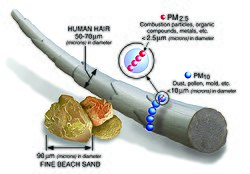
Back Fynstowwe Afrikaans جسيمات معلقة Arabic Цьвёрдыя часьцінкі BE-X-OLD Фини прахови частици Bulgarian पार्टिकुलेट मैटर Bihari Aerosol atmosfèric Catalan Pevné částice Czech Mater gronynnol Welsh Atmosfærisk støv Danish Feinstaub German


| Part of a series on |
| Pollution |
|---|
 |
Particulate matter (PM) or particulates[a] are microscopic particles of solid or liquid matter suspended in the air. An aerosol is a mixture of particulates and air, as opposed to the particulate matter alone,[1] though it is sometimes defined as a subset of aerosol terminology.[2] Sources of particulate matter can be natural or anthropogenic.[3] Particulates have impacts on climate and precipitation that adversely affect human health.
Types of atmospheric particles include suspended particulate matter; thoracic and respirable particles;[4] inhalable coarse particles, designated PM10, which are coarse particles with a diameter of 10 micrometers (μm) or less; fine particles, designated PM2.5, with a diameter of 2.5 μm or less;[5] ultrafine particles, with a diameter of 100 nm or less; and soot.
Airborne particulate matter is a Group 1 carcinogen.[6] Particulates are the most harmful form of air pollution[7] as they can penetrate deep into the lungs and brain from blood streams, causing health problems such as stroke, heart disease, lung disease, cancer and preterm birth.[8] There is no safe level of particulates. Worldwide, exposure to PM2.5 contributed to 7.8 million deaths in 2021, and of which 4.7 million from outdoor air pollution and the remainder from household air pollution.[9] Overall, ambient particulate matter is one of the leading risk factor for premature death globally.[10]
Cite error: There are <ref group=lower-alpha> tags or {{efn}} templates on this page, but the references will not show without a {{reflist|group=lower-alpha}} template or {{notelist}} template (see the help page).
- ^ Seinfeld J, Pandis S (1998). Atmospheric Chemistry and Physics: From Air Pollution to Climate Change (2nd ed.). Hoboken, New Jersey: John Wiley & Sons. p. 97. ISBN 978-0-471-17816-3.
- ^ Aerosol Measurement: Principles, Techniques, and Applications. Wiley. October 2001. ISBN 978-0-471-35636-3.
- ^ Plainiotis S, Pericleous KA, Fisher BE, Shier L (January 2010). "Application of Lagrangian particle dispersion models to air quality assessment in the Trans-Manche region of Nord-Pas-de-Calais (France) and Kent (Great Britain)" (PDF). International Journal of Environment and Pollution. 40 (1/2/3): 160–74. doi:10.1504/IJEP.2010.030891.
- ^ Brown JS, Gordon T, Price O, Asgharian B (April 2013). "Thoracic and respirable particle definitions for human health risk assessment". Particle and Fibre Toxicology. 10 (1): 12. Bibcode:2013PFTox..10...12B. doi:10.1186/1743-8977-10-12. PMC 3640939. PMID 23575443.
- ^ US EPA, OAR (19 April 2016). "Particulate Matter (PM) Basics". US EPA. Archived from the original on 29 September 2023. Retrieved 5 October 2019.
- ^ "EHP – Outdoor Particulate Matter Exposure and Lung Cancer: A Systematic Review and Meta-Analysis". ehp.niehs.nih.gov. Archived from the original on 29 May 2016. Retrieved 29 December 2016.
- ^ Wasley, Andrew; Heal, Alexandra; Harvey, Fiona; Lainio, Mie (13 June 2019). "Revealed: UK government failing to tackle rise of serious air pollutant". The Guardian. Archived from the original on 13 June 2019. Retrieved 14 June 2019.
- ^ Thangavel, Prakash; Park, Duckshin; Lee, Young-Chul (19 June 2022). "Recent Insights into Particulate Matter (PM2.5)-Mediated Toxicity in Humans: An Overview". International Journal of Environmental Research and Public Health. 19 (12): 7511. doi:10.3390/ijerph19127511. ISSN 1660-4601. PMC 9223652. PMID 35742761.
- ^ Health Effects Institute; Institute for Health Metrics and Evaluation; UNICEF (2024). State of Global Air Report 2024: A Special Report on Global Exposure to Air Pollution and its Health Impacts with a Focus on Children's Health. Health Effects Institute. pp. 3–4, 14. ISSN 2578-6873.
- ^ "The Weight of Numbers: Air Pollution and PM2.5". Undark. Archived from the original on 7 September 2018. Retrieved 6 September 2018.
© MMXXIII Rich X Search. We shall prevail. All rights reserved. Rich X Search